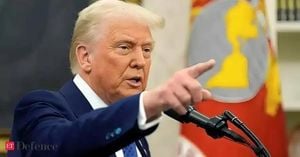In a dramatic move that is reverberating across Washington, Director of National Intelligence Tulsi Gabbard has announced a sweeping overhaul of the Office of the Director of National Intelligence (ODNI), pledging to slash the agency’s workforce by nearly half and save taxpayers at least $700 million per year. The reorganization, dubbed “ODNI 2.0,” marks the most significant shake-up in the agency’s two-decade history—and has ignited fierce debate over the future of U.S. intelligence.
The announcement came on August 20, 2025, with Gabbard detailing the changes in a memo to Congress and an internal email to ODNI employees. According to CNN, Gabbard has already reduced the ODNI’s staff by more than 500—a cut of roughly 30%—with more layoffs and reassignments on the horizon. The agency’s headcount is expected to drop from about 2,000 in February 2025 to around 1,300 by the end of September, according to senior ODNI officials cited by the Daily Mail and other outlets. Some employees will be let go, others reassigned, and many on loan from agencies like the CIA or FBI will return to their original posts.
“Over the last 20 years, ODNI has become bloated and inefficient, and the intelligence community is rife with abuse of power, unauthorized leaks of classified intelligence, and politicized weaponization of intelligence,” Gabbard declared in a statement, as reported by CNN. “ODNI and the IC must make serious changes to fulfill its responsibility to the American people and the U.S. Constitution by focusing on our core mission: find the truth and provide objective, unbiased, timely intelligence to the President and policymakers.”
The restructuring is not just about headcount. Gabbard’s “ODNI 2.0” plan targets several subagencies and departments she claims are either redundant or have become politicized. Among those slated for closure are the Foreign Malign Influence Center, which monitors foreign efforts to sway American public opinion; the National Counterproliferation and Biosecurity Center, focused on weapons of mass destruction; and the Cyber Threat Intelligence Integration Center, which handles cybersecurity. The External Research Council and the Strategic Futures Group—responsible for long-range forecasts—will also be shut down, with Gabbard’s team accusing the latter of pushing a partisan agenda in its annual Global Trends Report. The fact sheet provided to Congress alleged violations of analytic standards, though, as CNN notes, it offered no concrete evidence to support this claim.
Other changes are equally sweeping. The National Intelligence University, the intelligence community’s educational arm, will merge with the Pentagon’s National Defense University, shifting oversight from the ODNI to the Department of Defense. A satellite campus in Reston, Virginia, will close, and the National Intelligence Council will now report directly to ODNI headquarters. The agency is also returning detailees—employees on temporary assignment from other agencies—back to their original employers, and has been quietly reducing staff through attrition and deferred resignations, according to the Daily Mail.
The reforms have not come out of the blue. Multiple senior ODNI officials told the Daily Mail that the shake-up is closely aligned with President Donald Trump’s directive to root out what he has called the “deep state.” Gabbard herself reportedly briefed President Trump and National Security Advisor Marco Rubio on the plan two weeks before the public announcement, and the move has the president’s explicit blessing. “Mahalo,” Gabbard’s internal announcement to staff concluded—a nod to her Hawaiian roots, but also, perhaps, a signal that this is a new era for the intelligence community.
Supporters of the plan argue that the ODNI has strayed far from its original mission. Created in the aftermath of the September 11, 2001 attacks, the agency was intended to serve as a lean coordinating body, overseeing the nation’s sprawling intelligence apparatus and advising the president. But over the years, its workforce and budget have ballooned. The total annual budget for all U.S. intelligence agencies topped $100 billion last year, and many in Congress—on both sides of the aisle—have called for reform.
“Congress created the ODNI to be a lean organization that used small staffs to coordinate across the Intelligence Community and execute specific, important tasks,” said Senator Tom Cotton, chair of the Senate Intelligence Committee, in a statement quoted by CNN and the Daily Mail. “Today’s announcement is an important step towards returning ODNI to that original size, scope, and mission.” Cotton has previously introduced legislation to cap the number of ODNI employees at 650, though even some agency insiders worry that figure is too low to maintain essential functions.
Not everyone is convinced that Gabbard’s approach is the right one. Senator Mark Warner, the top Democrat on the Senate Intelligence Committee, acknowledged “broad, bipartisan agreement that the Office of the Director of National Intelligence is in need of thoughtful reform.” But he sharply criticized Gabbard’s record, saying, “Given Director Gabbard’s track record of politicizing intelligence—including her decision just yesterday to revoke security clearances from career national security officials—I have no confidence that she is the right person to carry out this weighty responsibility.” Warner’s reference to revoked security clearances highlights another contentious aspect of Gabbard’s tenure: her move to strip dozens of current and former officials of their access, accusing them of “politicization or weaponization of intelligence.”
Gabbard’s critics, especially among Democrats, have accused her of cherry-picking intelligence and releasing documents that, in their view, risk exposing sensitive sources and methods. She has been especially vocal about what she sees as past abuses in the intelligence community’s handling of Russian interference in the 2016 election, at times suggesting that Obama-era officials engaged in a “years-long coup” against President Trump—a charge dismissed by a spokesperson for former President Obama as “bizarre” and “ridiculous.”
Inside the ODNI, reactions to the cuts are mixed. Some senior officials, speaking anonymously to the Daily Mail, say the reforms will make the agency more agile and better able to respond to emerging threats such as artificial intelligence and foreign technology competition. “We have to move faster ... and pivot to an elite workforce,” one official said. Others, however, worry that the scale of the layoffs could undermine the agency’s ability to fulfill its mandate. There is also internal dissent over the elimination of diversity, equity, and inclusion (DEI) initiatives, which some officials blame for earlier departures from the agency.
For now, the future of the ODNI—and the broader intelligence community—remains uncertain. Gabbard’s “ODNI 2.0” sets a precedent that could ripple through other agencies like the CIA and FBI, as officials hint that similar reforms may be on the horizon. Whether these changes will restore public trust and streamline intelligence, or simply shift the balance of power in new and unpredictable ways, is a question that only time will answer.
One thing is clear: with the agency’s workforce shrinking and its mission refocused, America’s intelligence establishment is entering uncharted territory—one where the stakes, and the scrutiny, have never been higher.






